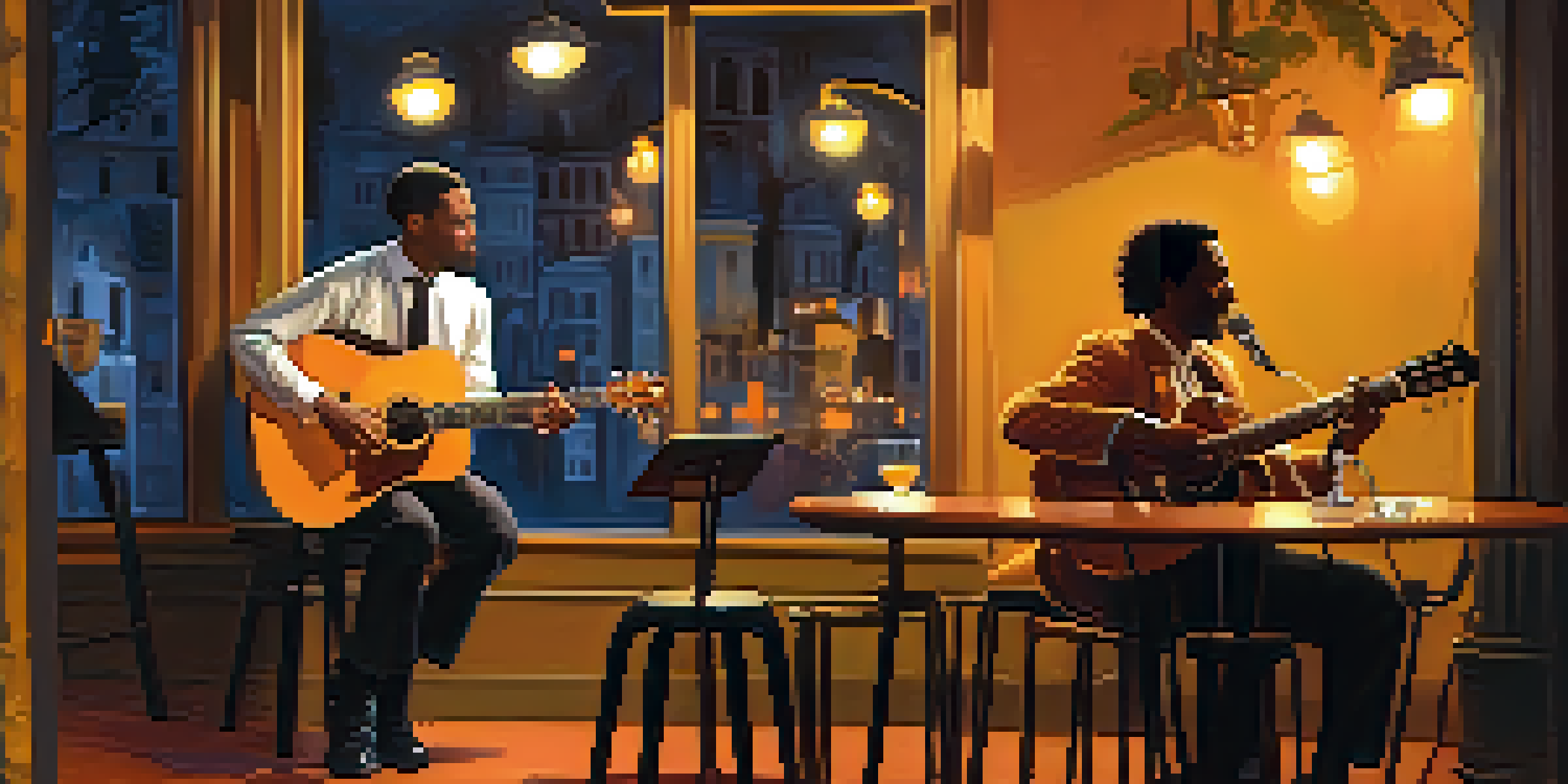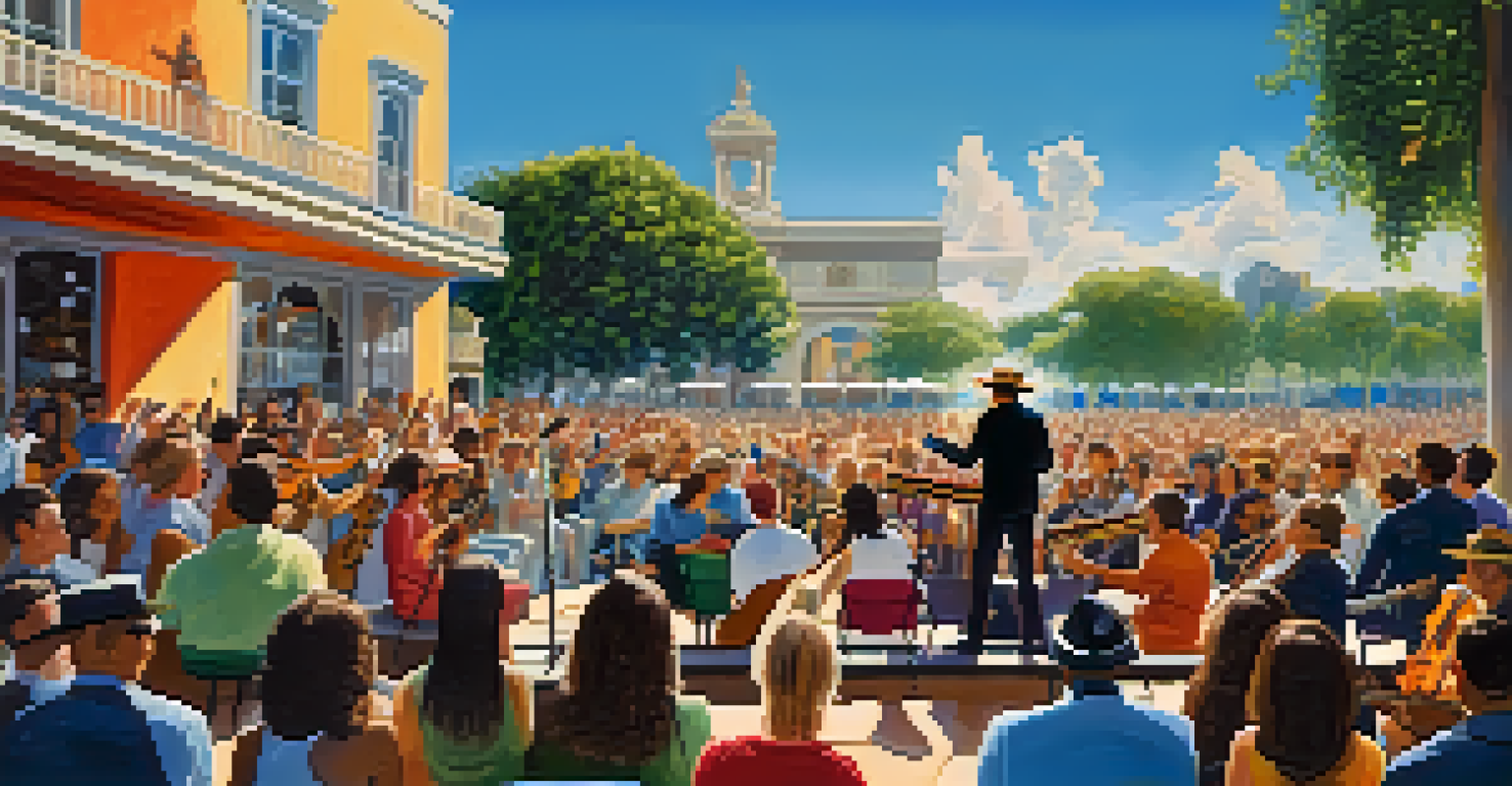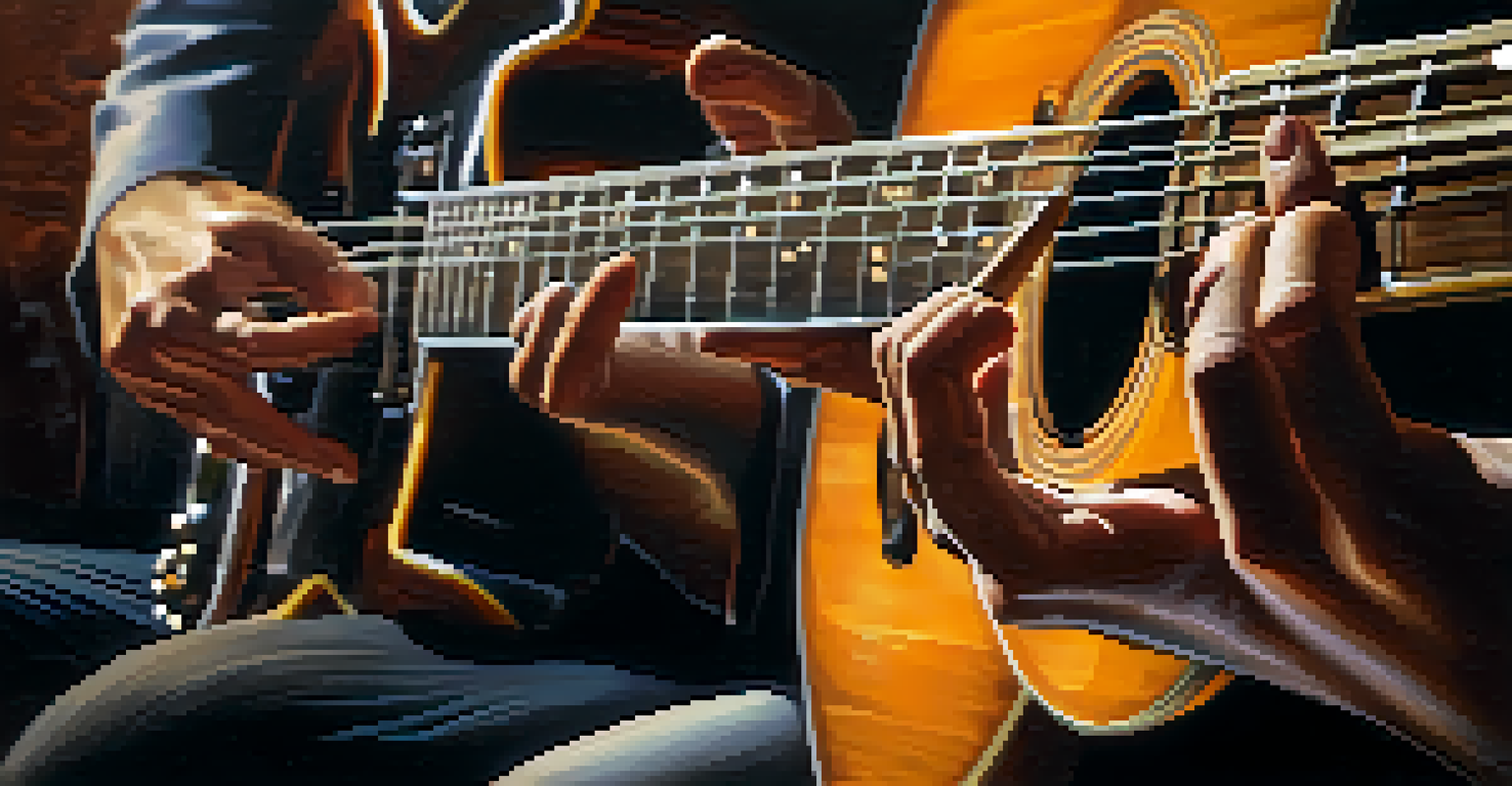Jazz Guitar Duets: Notable Collaborations and Influences

The Art of Jazz Guitar Duets: A Unique Musical Conversation
Jazz guitar duets are like a musical conversation, where two guitarists engage in a dance of notes and rhythms. This format allows for a rich exchange of ideas, emotions, and improvisation, showcasing the unique styles of each artist. Whether it's a gentle interplay or a fiery exchange, the synergy created in these duets can lead to some of the most memorable moments in jazz.
Music is the shorthand of emotion.
The intimacy of duets often brings out the best in guitarists, pushing them to explore new territories and take creative risks. For instance, when two skilled players collaborate, they can build on each other’s ideas, crafting intricate harmonies and weaving complex melodies. This collaborative spirit is a hallmark of jazz, encouraging musicians to listen deeply and respond in real-time.
In essence, jazz guitar duets encapsulate the heart of jazz itself: spontaneity, collaboration, and a deep connection between musicians. It's this dynamic that makes each performance unique, as no two duets are ever the same. The beauty lies not just in the music produced, but in the shared experience of creating it together.
Notable Collaborations: Legends of the Jazz Guitar
Throughout jazz history, numerous legendary guitarists have come together to create unforgettable duets. One notable pairing is the collaboration between Wes Montgomery and Jimmy Smith, whose album 'Further Adventures of Jimmy Smith' showcases their incredible chemistry and improvisational skills. Their ability to blend Montgomery's smooth, melodic lines with Smith's powerful organ creates a rich tapestry of sound.

Another iconic partnership is that of Pat Metheny and John Scofield, who have both pushed the boundaries of jazz guitar. Their work together, particularly in live settings, highlights their contrasting yet complementary styles. Metheny's lyrical phrasing and Scofield's bluesy, expressive lines create a dialogue that captivates audiences.
Jazz Duets: A Unique Collaboration
Jazz guitar duets create a dynamic conversation through improvisation, allowing musicians to explore and express their artistry together.
These collaborations not only highlight the individual talents of each guitarist but also demonstrate how two musicians can elevate each other’s artistry. The impact of such partnerships resonates through the jazz community, inspiring new generations of guitarists to explore the art of collaboration.
Influences on Jazz Guitar Duets: A Melting Pot of Styles
Jazz guitar duets draw from a wide range of influences, reflecting the diverse musical landscape that surrounds them. From blues and rock to classical and folk, these genres contribute to the rich vocabulary that guitarists use in their improvisations. This fusion of styles creates a distinctive sound that keeps jazz fresh and engaging.
The beauty of jazz is that it’s not about the notes you play, it’s about the notes you don’t play.
For example, the influence of blues can be heard in the phrasing and expressive techniques used by many jazz guitarists. Artists like B.B. King have inspired countless jazz musicians to incorporate those emotive, bending notes into their playing. This cross-pollination leads to innovative sounds and new approaches to jazz guitar duets.
Moreover, the ever-evolving nature of jazz allows guitarists to continuously experiment and redefine their sound. The incorporation of modern genres, such as funk and electronic music, into jazz guitar duets showcases this adaptive spirit, ensuring that the art form remains vibrant and relevant.
Iconic Albums Featuring Jazz Guitar Duets
Several albums stand out in the realm of jazz guitar duets, serving as essential listening for any enthusiast. One such album is 'Django Reinhardt and Stéphane Grappelli – The Quintet of the Hot Club of France,' which captures the essence of gypsy jazz. Their synergy, characterized by Reinhardt's virtuosic guitar work and Grappelli's soaring violin, creates an enchanting soundscape that has influenced countless musicians.
Another noteworthy album is 'Guitar Duets' by Jim Hall and Pat Metheny, which showcases their deep appreciation for melody and harmony. Their collaborative effort illustrates the beauty of improvisation and the emotional depth that can emerge when two master guitarists come together. It's an album that exemplifies how duets can push artistic boundaries while remaining deeply connected to jazz traditions.
Influential Guitar Partnerships
Notable collaborations, such as those between Wes Montgomery and Jimmy Smith, showcase how guitarists can elevate each other's artistry and inspire future generations.
These albums not only feature exceptional musicianship but also highlight the power of collaboration in jazz guitar duets. They serve as a testament to the creativity and artistry that can arise when talented musicians join forces, inspiring listeners and paving the way for future generations.
The Role of Improvisation in Jazz Guitar Duets
Improvisation is at the heart of jazz guitar duets, allowing musicians to express themselves freely and spontaneously. Unlike many other musical genres, jazz embraces the unknown, encouraging guitarists to take risks and explore new ideas in real-time. This improvisational spirit is what makes each performance unique and captivating.
In a duet setting, improvisation often involves a back-and-forth exchange, where one guitarist lays down a foundation while the other responds with spontaneous melodies and riffs. This interplay creates a dynamic musical conversation, where both musicians are equally invested in the outcome. The joy of discovery is palpable, as they navigate through complex chord progressions and unexpected musical twists.
Moreover, the improvisational aspect of jazz guitar duets fosters a sense of collaboration and trust between musicians. They must listen closely to each other, reacting and adapting to their partner's playing. This connection not only enhances the music but also deepens the bond between the guitarists, creating a shared experience that resonates with audiences.
The Influence of Jazz Guitar Duets on Modern Jazz
Jazz guitar duets have played a significant role in shaping modern jazz, influencing the way musicians approach collaboration and improvisation. The rich tradition of duet playing encourages contemporary artists to explore new sounds and styles, often blending genres in innovative ways. This evolution can be seen in the work of modern guitarists who draw inspiration from the duets of the past.
For instance, guitarists like Gilad Hekselman and Julian Lage have taken the concept of duets to new heights, experimenting with various musical elements while staying rooted in jazz. Their collaborations often incorporate influences from world music, electronic sounds, and even classical elements, showcasing the versatility of jazz guitar duets in a modern context.
Future Trends in Jazz Duets
Emerging trends in technology and cross-genre collaborations promise to push the boundaries of jazz guitar duets, keeping the art form vibrant and relevant.
This blending of styles not only keeps jazz relevant but also attracts a diverse audience, inviting listeners from various musical backgrounds to appreciate the artistry of jazz guitar. As these modern guitarists continue to push boundaries, the tradition of jazz guitar duets remains a vital part of the genre's evolution.
Future of Jazz Guitar Duets: Trends and Innovations
As we look to the future of jazz guitar duets, several trends and innovations are emerging that promise to shape the genre. One notable trend is the increasing use of technology, allowing guitarists to experiment with new sounds and recording techniques. This technological integration can lead to exciting collaborations, even between musicians who are miles apart.
Another innovation is the rise of cross-genre collaborations, where jazz guitarists team up with artists from different musical backgrounds. This blending of styles not only enhances creativity but also broadens the appeal of jazz guitar duets to a wider audience. As musicians explore these new frontiers, we can expect to hear fresh perspectives that challenge traditional notions of jazz.

Ultimately, the future of jazz guitar duets looks bright, with an exciting mix of innovation, collaboration, and exploration on the horizon. As artists continue to push the boundaries of their craft, they will undoubtedly inspire new generations of guitarists to join in the conversation, ensuring that jazz remains a dynamic and evolving art form.